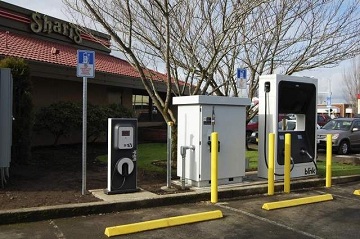Plugged in: Oregon finishes I-5 quick-charge station corridor
 In the time it takes to order a cup of coffee and have a slice of pie, electric-vehicle owners can charge their batteries and continue their gas-free journeys.
In the time it takes to order a cup of coffee and have a slice of pie, electric-vehicle owners can charge their batteries and continue their gas-free journeys.Those journeys also can stretch a little farther now that Oregon has more quick-charge stations for drivers along the way.
Oregon’s recently added stations, including a quick-charge one at the Shari’s Cafe and Pie restaurant in Keizer, complete the Beaver State’s portion of the West Coast Electric Highway. When other states finish their portions, it ultimately will span 1,300 miles along the Interstate 5 corridor between British Columbia and Baja California.
The West Coast Electric Highway is tri-state effort of Washington, Oregon and California, and when completed, there will be quick-charge stations every 25 to 60 miles. Quick-charge stations can typically charge a battery in 20 to 30 minutes. Depending on battery-charge levels, it can take between four to eight hours at a non-quick charge station.
Oregon completed its segment of the freeway as part of a group effort, getting help from a variety of projects and partners.
Portland General Electric joined with ECOtality, the company that manufactures the stations, through the Electric Vehicle Project to install the stations that completed the northern portion of the state’s corridor.
The EV Project, funded by the U.S. Department of Energy, collects and analyzes data from electric-vehicle use, the effectiveness of charging infrastructure in homes and commercial use and the potential revenue systems. The information is used to help streamline the next generation of EVs.
Stan Sittser, transportation electrification project manager with PGE, said partnering with ECOtality made the process of finding suitable host sites such as the Shari’s in Keizer more efficient.
To participate, the host business sacrifices a couple of parking spots, but ECOtality provides the equipment and PGE helps with the installation, he said.
“It’s been a good partnership,” he said.
Jodenne Scott, director of financial services for Shari’s, said having the stations at the restaurant coincides with the company’s efforts to reduce its carbon footprint.
The other locations for PGE’s part of the project include a southeast Portland Burgerville, Woodburn’s Elmer’s restaurant, the Clackamas Town Center and Wilsonville Town Center.
The Oregon Department of Transportation completed the southern stretch of the state freeway with 10 quick-charge stations along I-5 last March.
Art James, senior project executive for ODOT’s office of innovative partnerships, said American Recovery and Reinvestment Act funds from the Oregon Department of Energy enabled the state to install the AeroVironment fast-chargers.
Together with the ECOtality stations, the state’s corridor is complete.
“By having a network of easy-to-use chargers people can get around the state and charge up when they need to,” James said.
The stations are similar to filling stations, but EV users plug in to get an electric charge as opposed to a gasoline fill-up. The stations use J1772 connectors which are standard for new EVs in the market.
But consumers have to be prepared, and have the appropriate access to the chargers. Some require key fobs and others, cards.
Both AeroVironment and ECOtality stations require different access methods which can be obtained from their websites.
James said drivers should have both handy — just in case.
“These are growing pains,” he said, adding like most new technology, it may take time for there to be one standardized access method, which he added, is in the works.
ODOT’s plans to provide EV charging stations don’t end with the completion of the I-5 corridor.
The state is working to install 33 more AeroVironment fast-charge stations through the Transportation Investment Generating Economic Recovery, or TIGER project. Upon completion, there will be fast-chargers along the Gorge, at the Coast, in Central Oregon and in the Willamette Valley, all designed to increase the sustainable transportation infrastructure.
You can return to the main Market News page, or press the Back button on your browser.

